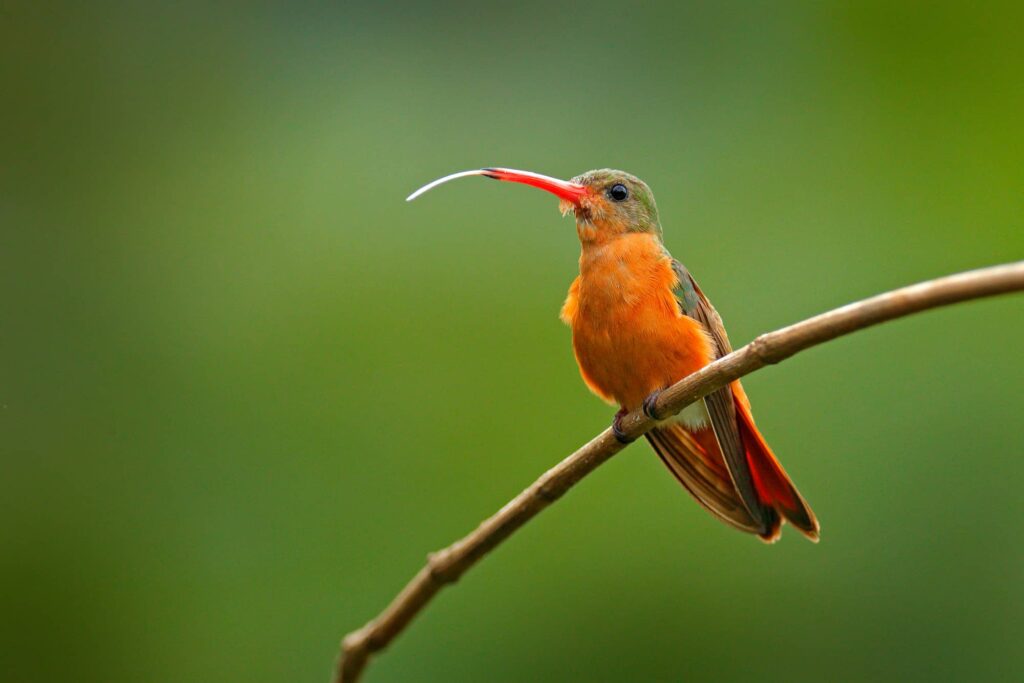New Mexico is famous for its beautiful landscape with stunning deserts, pure snow-capped mountains, and outstanding national monuments. With its combination of European American, Native American, and Mexican heritage, this state is an extraordinary place for you to visit.
There are seventeen species of hummingbirds known to soar around New Mexico each year. There are two periods that hummingbirds migrate to this state, from late March to April and September to early October.
Let us look at these seventeen types of charming hummingbirds and their uniqueness, which are a must-see when visiting New Mexico.
17 Hummingbirds Species Found In New Mexico
Costa’s Hummingbird
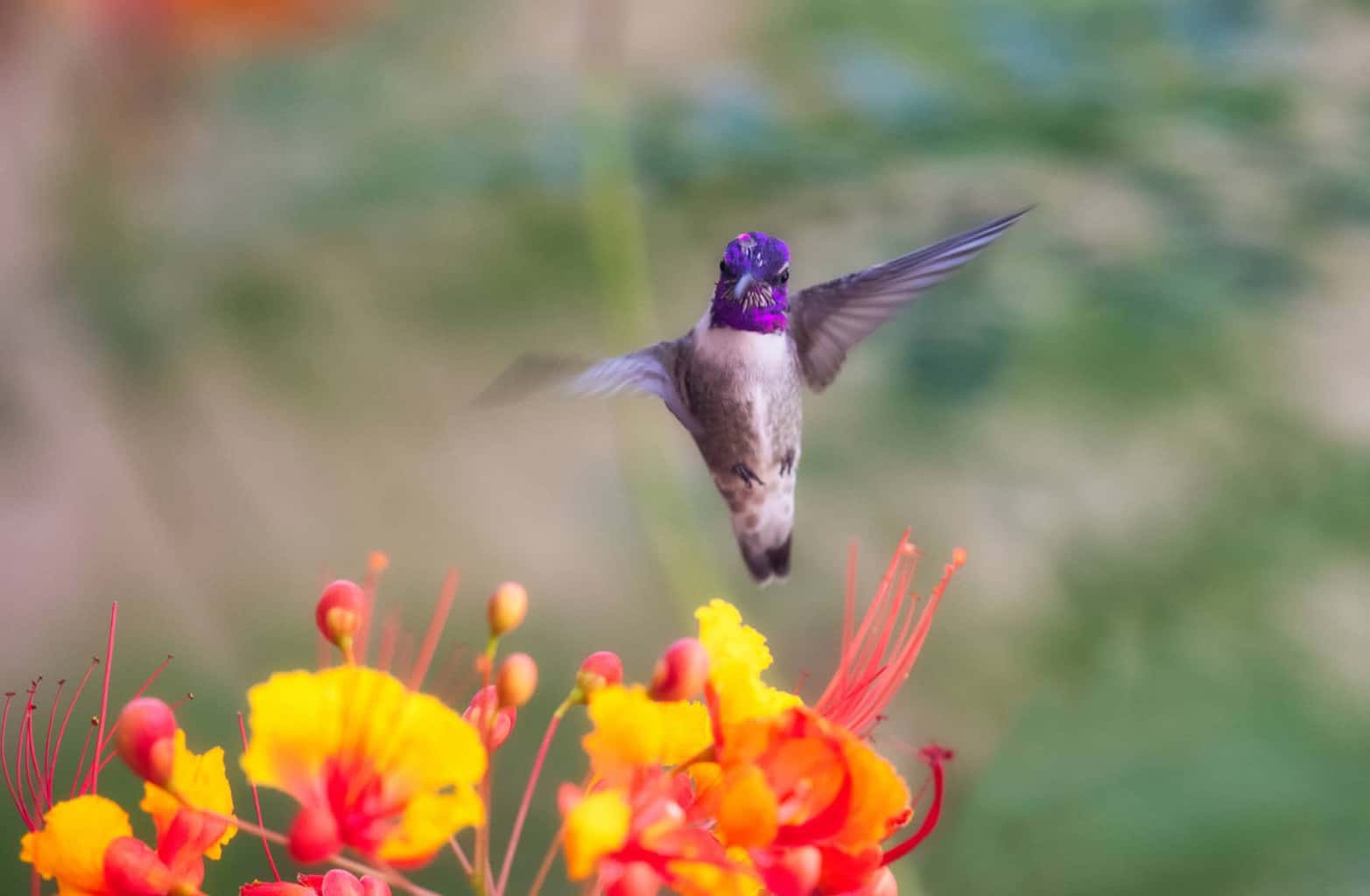
- Scientific name: Calypte costae
- Length: 3.0 – 3.5 inches
- Weight: 0.11 ounce
- Wingspan: 4.3 inches
Males have a glossy purple crown and purple throat patches that extend down the sides, giving it a “mustache” look. They also have metallic bluish=green tails.
Female hummingbirds have a grayish-green color on the top of their heads, and the neck below is whitish, with some black spotting, and they have green tail feathers.
They are desert hummingbirds and are often found in, strangely enough, deciduous forests, arid brushy environments, and near any hummingbird garden within the southwestern United States.
Costa hummingbirds can slow down their metabolism during freezing nights and enter a hibernation-like process known as torpor. As a result, their heart and respiration rate slows considerably.
Black-Chinned Hummingbird
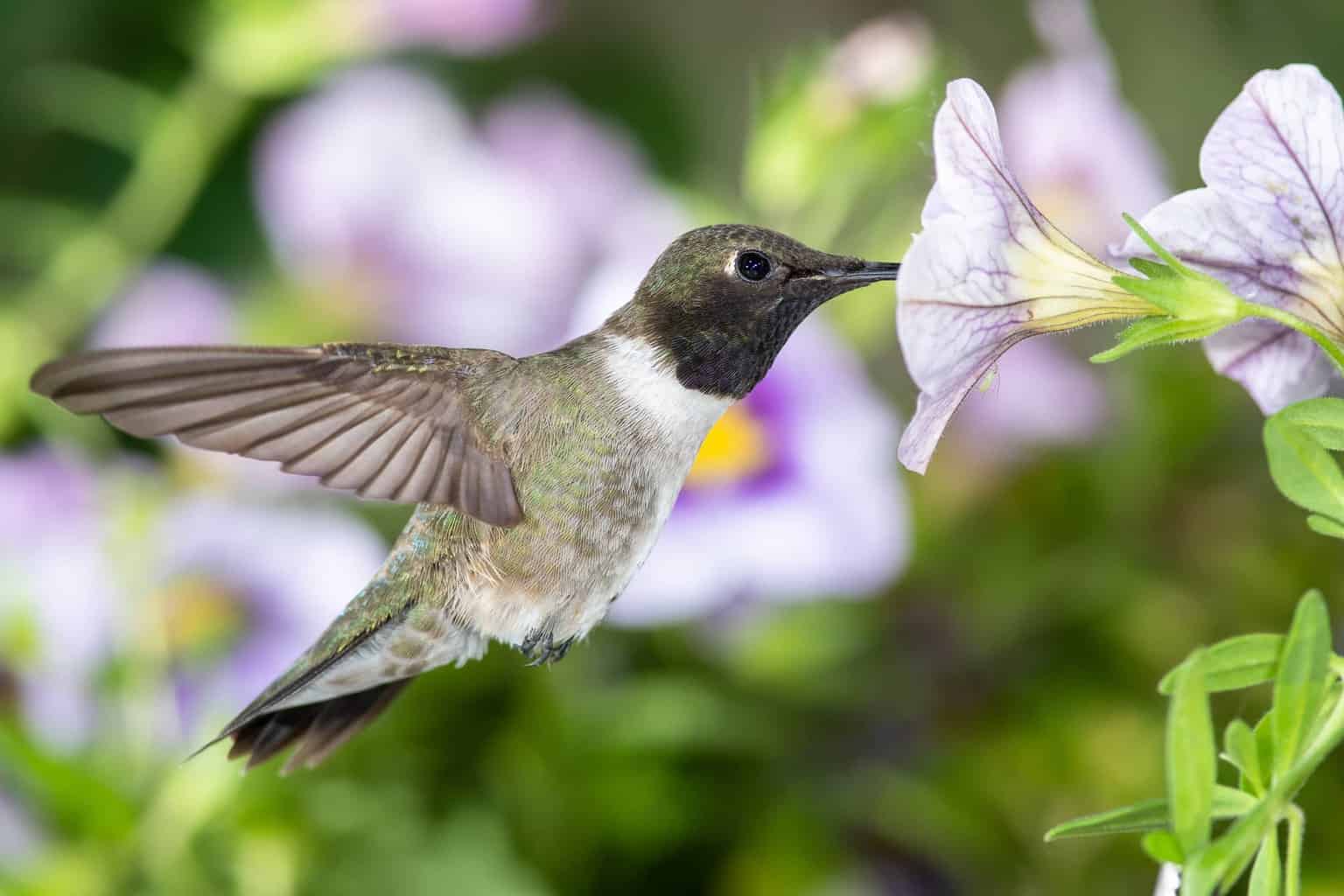
- Scientific name: Archilochus alexandri
- Length: 3.5 inches
- Weight: 0.1 – 0.2 ounce
- Wingspan: 4.3 inches
The Black-chinned Hummingbird Male has a shiny black throat with purple along the edge and pale feathers below to create a collar. The back is a green color with green feathers covering the chest. They also have greenish flanks.
The Black-chinned Hummingbird female has a white breast with some speckles along the throat.
Black-chinned Hummingbirds hover at tubular flowers and their favorite hummingbird feeders and dart erratically to catch tiny insects. When the weather is cold, they can consume up to three times their body weight daily. They perch on high branches of dead trees to survey the territory, watching out for other competitors to chase away or flying insects to eat.
This common species is found in many areas, from lowland deserts to mountain forests, and urbanized areas as long as tall trees and flowering shrubs and vines are present.
Broad-Tailed Hummingbird
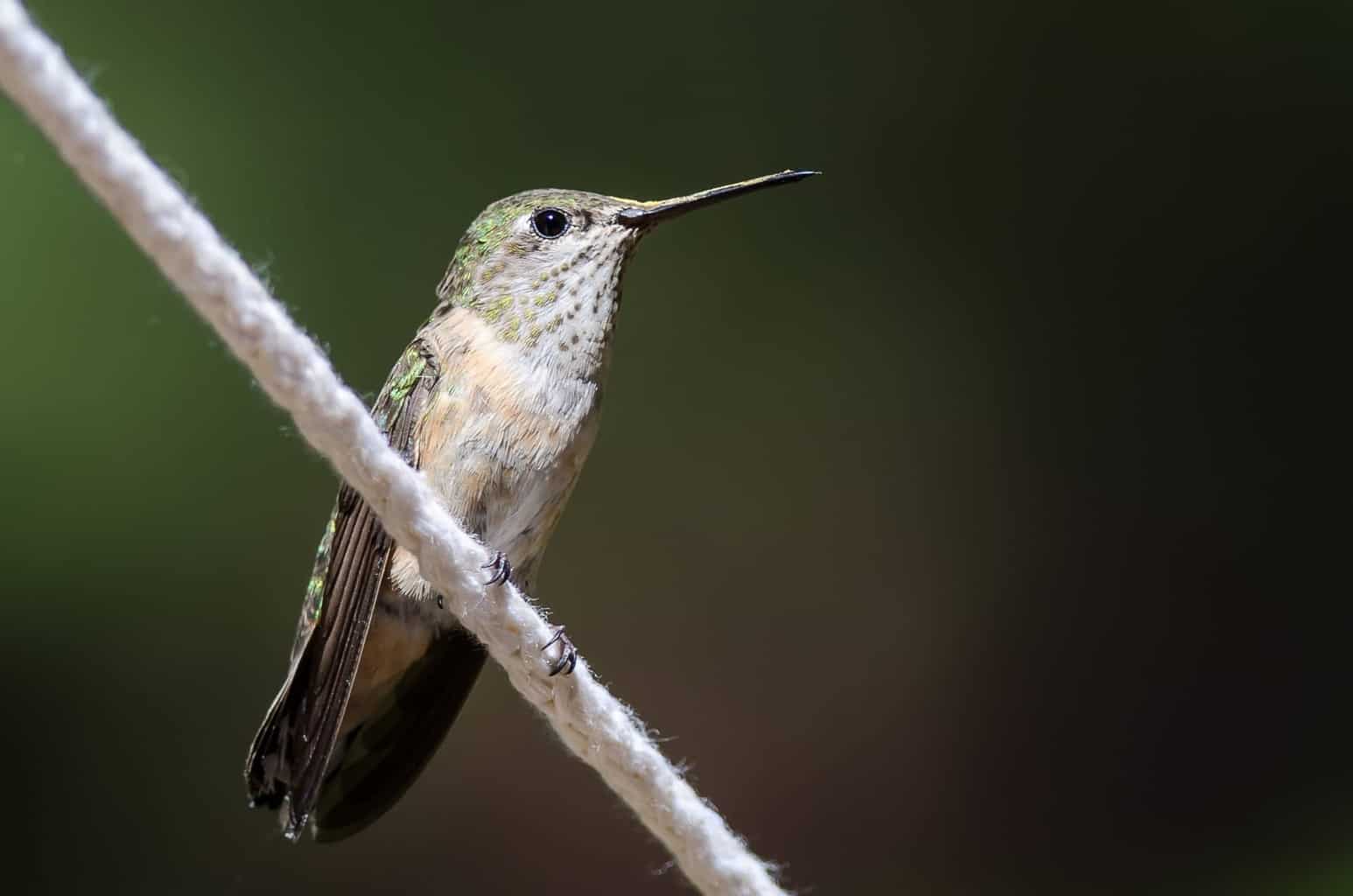
- Scientific name: Selasphorus platycercus
- Length: 4 inches
- Weight: 0.13 ounce
- Wingspan: 5.25 inches
Broad-tailed hummingbirds have a shiny green back, a white eye-ring, and a rounded black tail.
Males have shimmery, rose-red throats, white chest feathers, and a metallic green back.
The throat of a female is primarily pale, and the upper breast is white. Her tail changes from a rust color to black and then white at the tip. She has a brownish belly.
Broad-tailed Hummingbirds scavenge in flowered open areas or grasslands beside trees and shrubbery. Their areas for breeding are mainly in subalpine meadows, montane valleys, foothills, and strands of aspen or spruce in New Mexico’s national forests.
During the winter, these birds are capable of entering a state of torpor to survive the cold nights. They have the ability to lower their body temperature and heart rate until the sun comes up.
The male will display an aerial performance during the breeding season to attract the female. Males will fly high and swoop down while creating a trill sound with their wing feathers.
Rufous Hummingbird
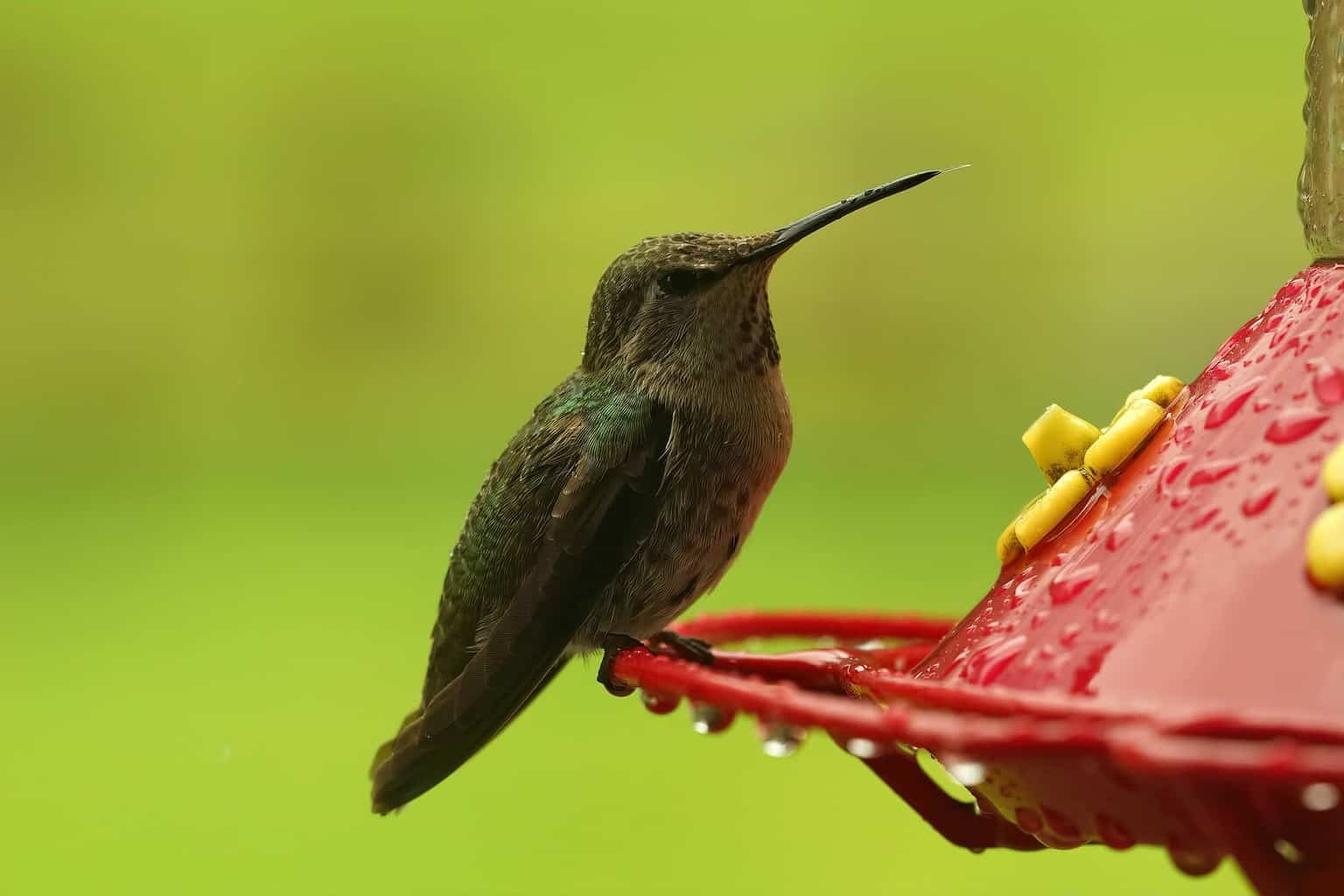
- Scientific name: Selasphorus rufus
- Length: 2.8 – 3.5 inches
- Weight: 0.071 – 0.176 ounce
- Wingspan: 4.3 inches
Males have a white chest and a rufous face, flanks, and tail with a beautiful reddish-orange iridescent throat.
Females have a green crown, white and shiny orange feathers in the center of their speckled throat and a tail with a rufous base and white tips.
The Rufous hummingbirds’ breeding habitats are open areas, forest edges, and mountainsides in western North America, from southern Alaska through British Columbia and the Pacific Northwest to California.
Females will build nests in secure, protected locations such as shrubs or conifers. Males are promiscuous as they often mate with several females.
Males are also very aggressive hummingbirds and will pursue larger hummingbirds that they perceive to be territorial invaders.
Calliope Hummingbird
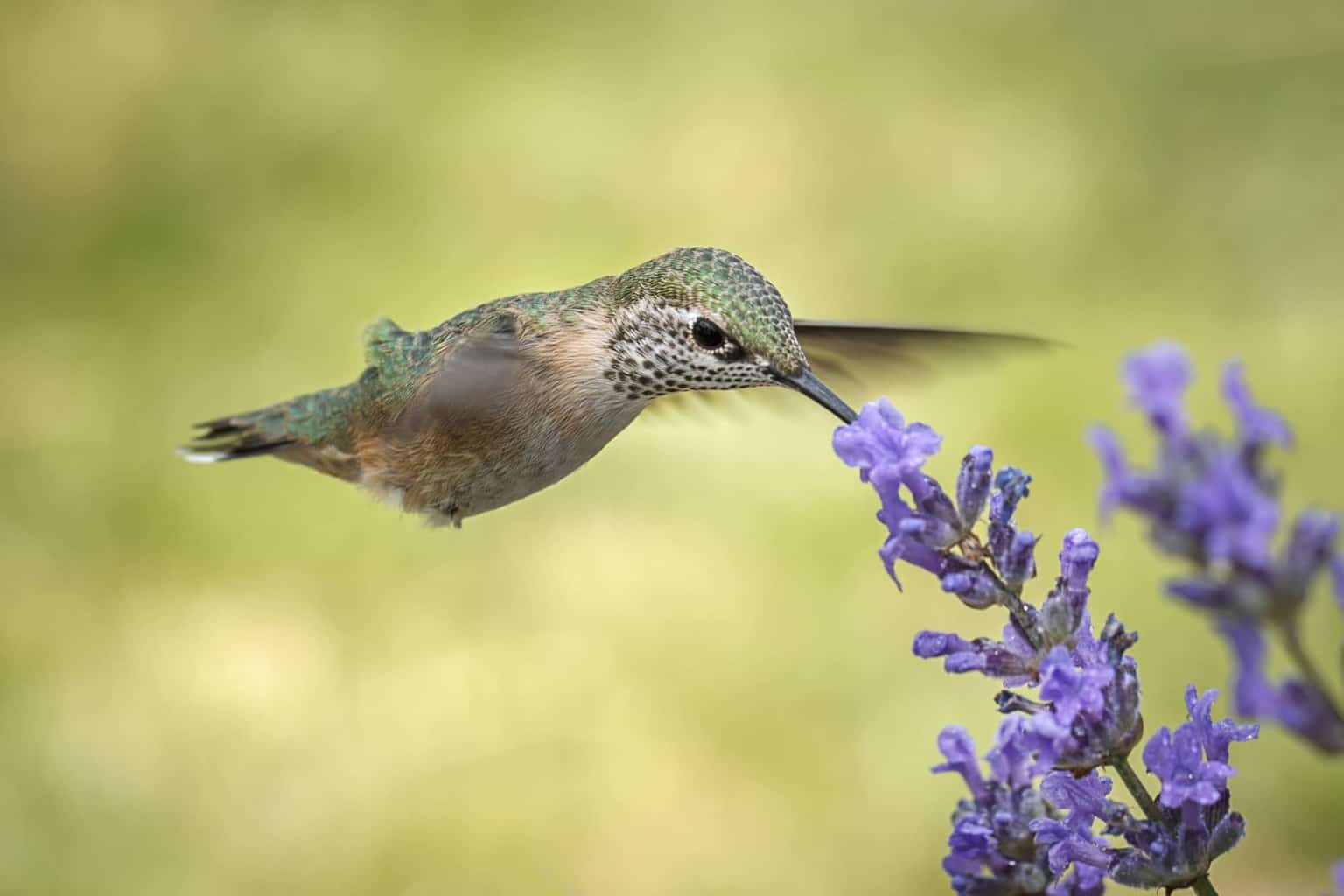
- Scientific name: Selasphorus calliope
- Length: 2.8 – 3.9 inches
- Weight: 0.071 – 0.106 ounce
- Wingspan: 4.3 inches
Males have a glossy green color on their backs and crowns with white underparts and magenta throat feathers. They have dark red streaks below the chin, green flanks, and a dark tail.
Females have dark streaks on their white throat, a pinkish wash on their flanks, and a whitish belly.
The breeding habitats of this magnificent hummingbird vary among open shrubs and altitudes. Nesting often happens at higher altitudes in the Rocky Mountains.
They are migratory birds with a very long migration route, so they generally move earlier than most birds to feed on the late-summer flowers in the mountains of western North America before going home to Mexico in the winter.
Broad-Billed Hummingbird
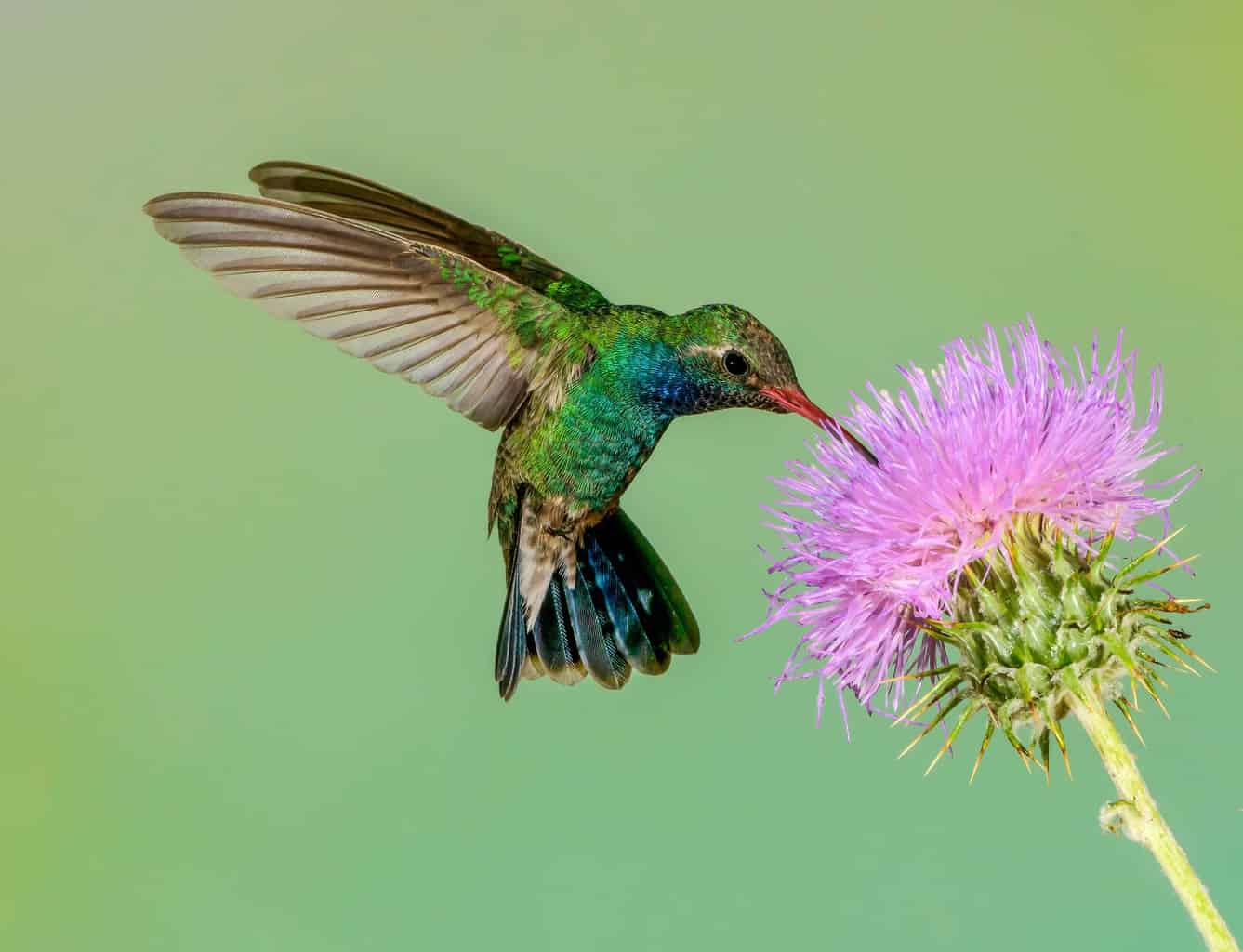
- Scientific name: Cynanthus latirostris
- Length: 3.1 – 3.9 inches
- Weight: 0.10 – 0.14 ounce
- Wingspan: 5.1 inches
The male has a green body with white undertail coverts and a blueish-green throat. The tail has a blackish-blue color.
Females have a light-colored belly and white eye stripes behind their eyes which match their white-tipped tails. They also have a black beak.
Broad-billed Hummingbirds live along streams and oak woodlands, preferring areas with streamside groves and dense vegetation.
This beautiful bird is known to visit sugar-water feeders, and they most frequently feed on red and yellow flowers.
Violet-Crowned Hummingbird
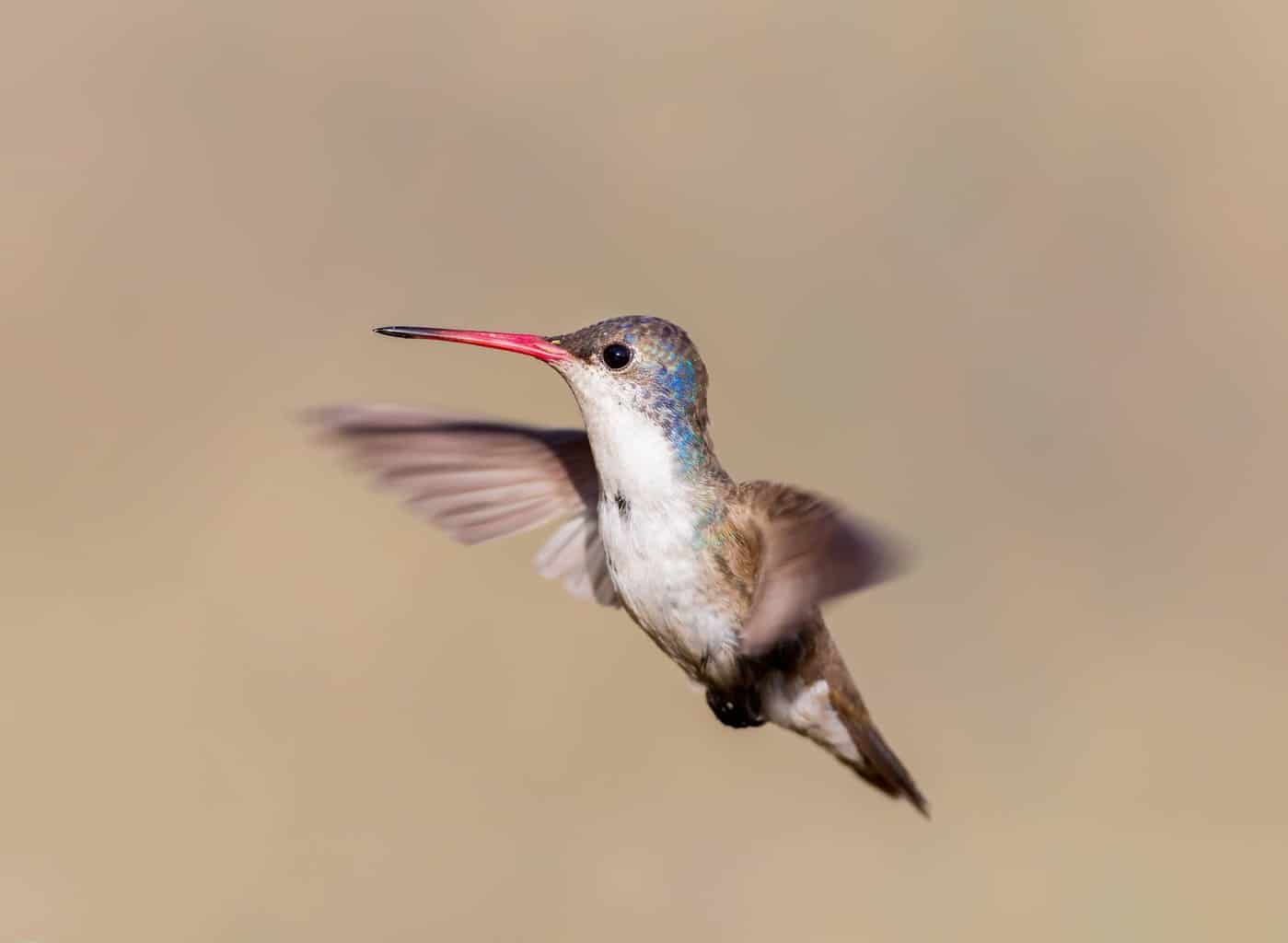
- Scientific name: Leucolia violiceps
- Length: 3.9 inches
- Weight: 0.18 ounce
- Wingspan: 5.5 inches
Males have a white under plumage and a glossy bluish-violet crown. The back is emerald green, and the tail is a dark brown or olive green.
Females look similar to males, but their plumage is less colorful, and they have lighter and greener crowns.
Being a mountain species, Violet-crowned hummingbirds locate their breeding grounds in the arid scrubs of southeastern Arizona to southwestern Mexico (the Madrean Sky Islands).
This favorite bird species eats nectar from flowers and blossoming trees using an extendable long tongue and catches insects on the wing.
Anna’s Hummingbird
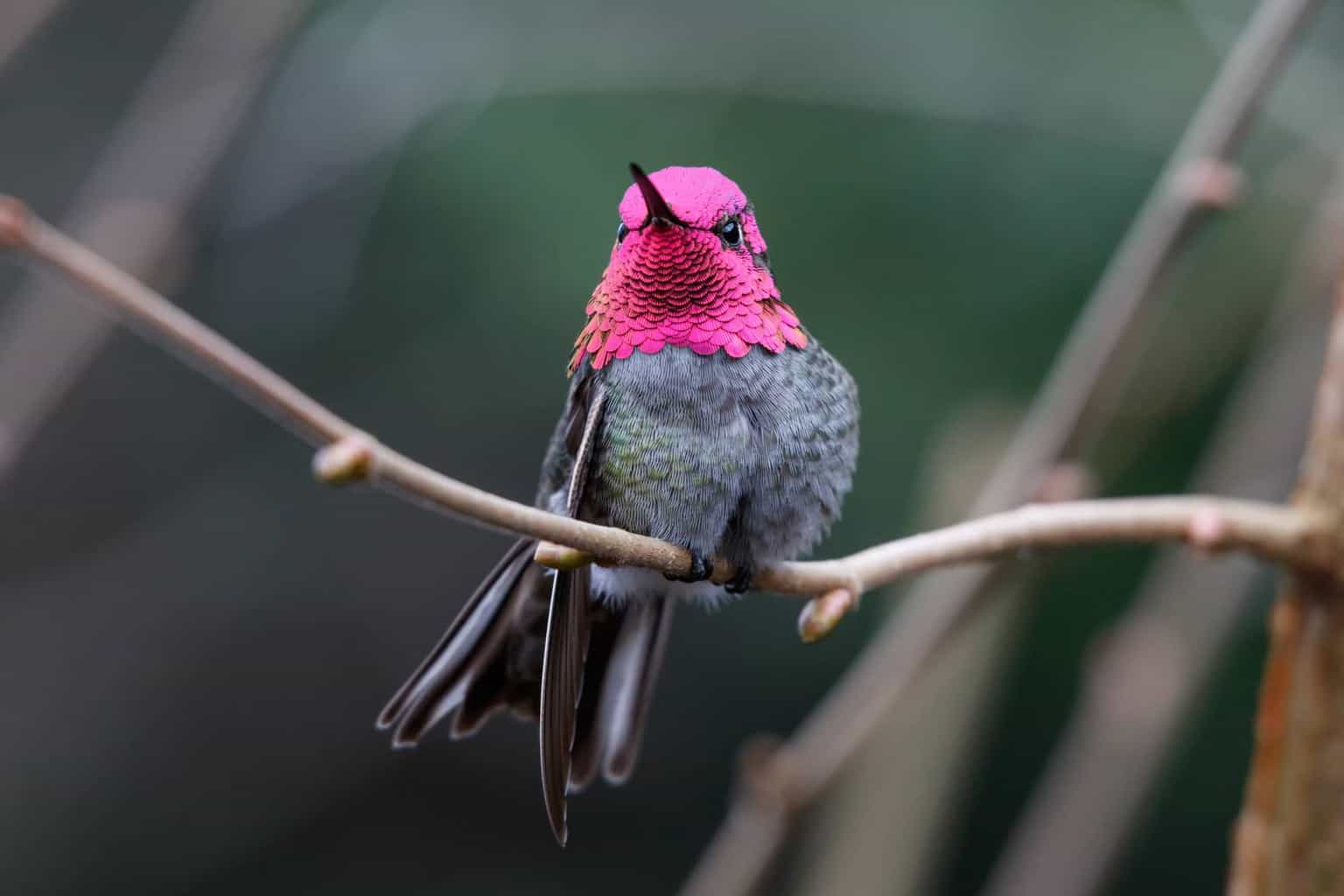
- Scientific name: Calypte anna
- Length: 3.9 – 4.3 inches
- Weight: 0.1 – 0.2 ounce
- Wingspan: 4.7 inches
Males have glossy dark-red throats and crowns, the underside appears gray, and the back is metallic green. They are tiny birds no larger than a ping pong ball.
Females have a light gray chest, white and red spotting on the throat, greenish backs, and white-tipped tails.
Male Anna’s Hummingbirds have more colorful crowns and more intense iridescence in their head feathers than other male birds because they have higher protein levels in their diet.
While collecting nectar from plants, these birds help with plant pollination. While they are in flight, they generate an electrostatic charge that attracts pollen to their beaks and feathers, assisting in transferring pollen grains to hundreds of flowers.
Their favorite hangouts are backyards, gardens, and eucalyptus trees.
Lucifer Hummingbird
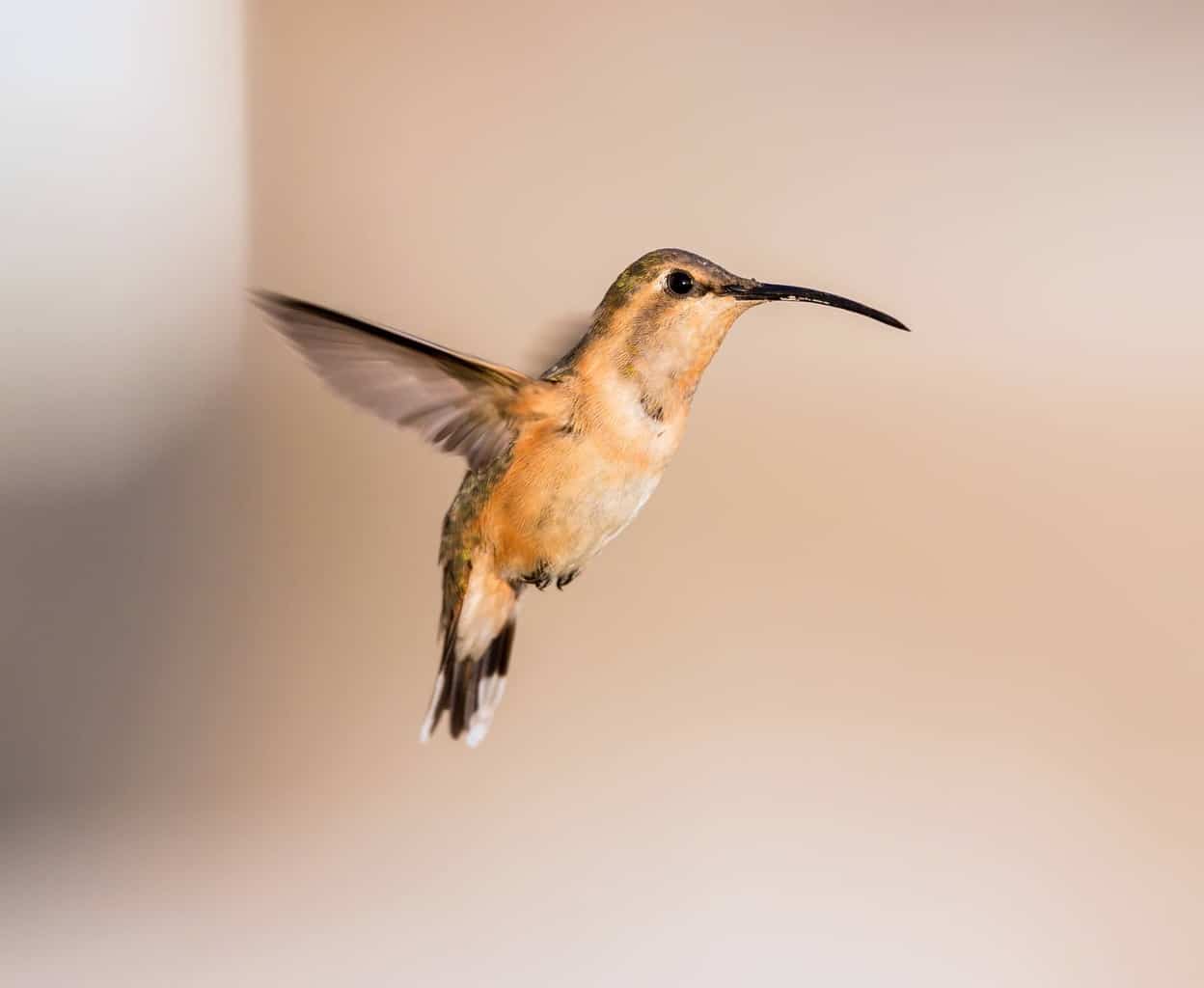
- Scientific name: Calothorax or Trochilus lucifer
- Length: 3.5 inches
- Weight: 0.10 – 0.11 ounce
- Wingspan: 4 inches
Males have a shimmering magenta throat patch that extends down the sides and is bordered by white. Males have deeply forked tails, while females have white tips on tails that aren’t forked.
Females are larger, have no glossy throat patch, and are light brown around the chest and throat region.
They have a buffy throat, a down-curved bill, and a thin white patch behind the eyes.
The longest recorded lifespan of a Lucifer hummingbird in the wild was 4.1 years. However, the lifespan of these hummingbirds can range from 3 to 5 years, depending on where they are located.
Lucifers hover and make quick, precise flights between perches, the nest, and feeding areas like other hummingbird species.
Blue-Throated Hummingbird
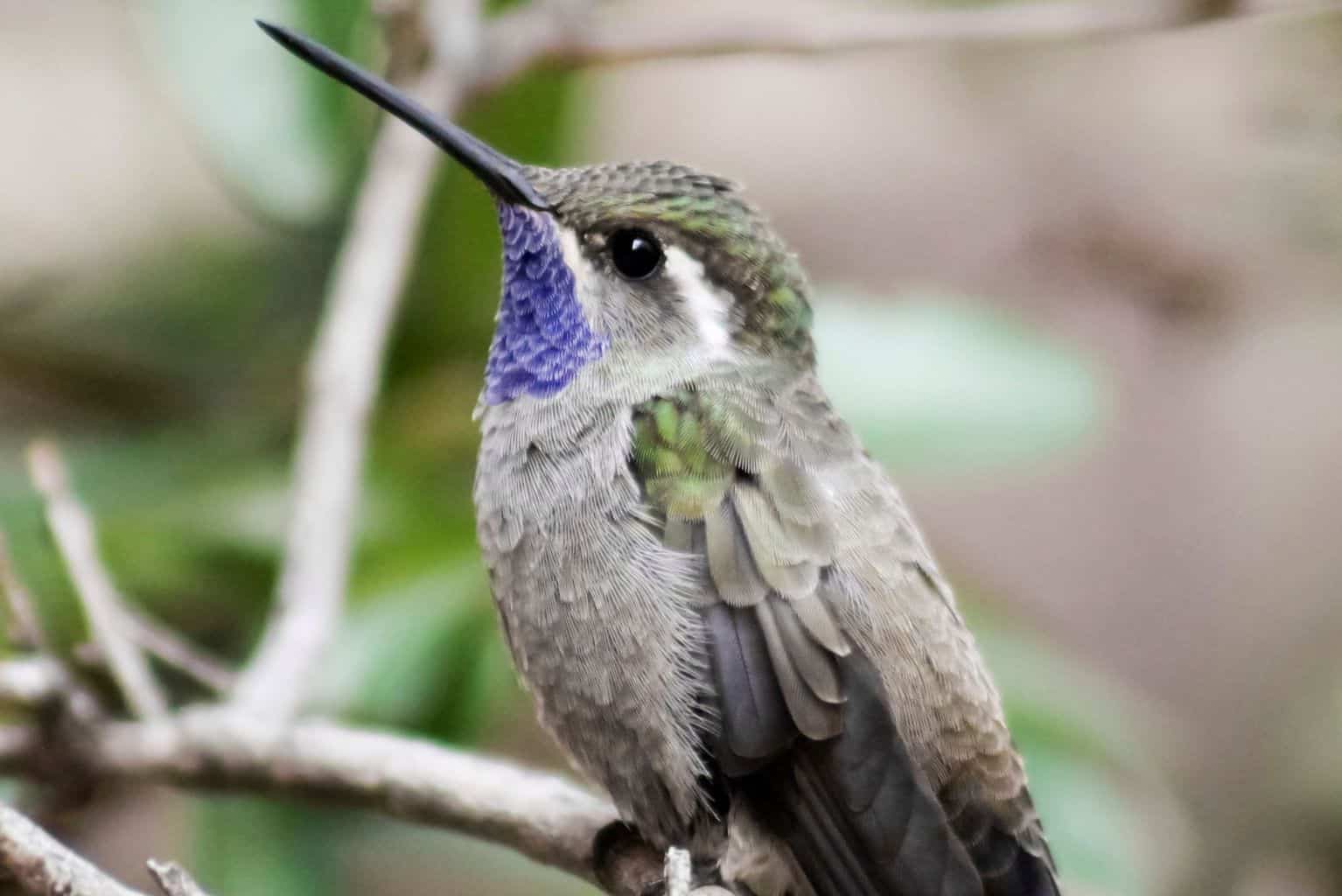
- Scientific name: Lampornis clemenciae
- Length: 4.5 – 4.9 inches
- Weight: 0.21 – 0.35 ounce
- Wingspan: 2.7 inches
Males and females have a shade of a dull green on their upper plumage, fading to a gray on the underside. Both have white stripes behind the eyes and thinner lines proceeding backward from the corner to their bill. They have black tail feathers with broad white tips. Males have a glossy blue throat patch while females have gray throats and a gray breast.
The Blue-throated Mountain Gem, as it is also called, is the largest hummingbird to visit the United States and is native to the mountain woodlands of Mexico. However, during the summer, they stay in wooded canyons in the Madrean Sky Islands of southeastern Arizona, southern Mexico, and western Texas.
The nest is built from soft plant fibers, held together using strands of spider silk gathered from spider webs. The exterior is then camouflaged with green mosses where available.
White-Eared Hummingbird
- Scientific name: Basilinna leucotis
- Length: 3.5 – 3.9 inches
- Weight: 0.10 – 0.14 ounce
- Wingspan: 4.5 inches
Both males and females have a white stripe.
The White-eared hummingbird male is primarily colored green on its upperparts and breast and have dark wings. The undertail is colored white, and the tail is straight and a bronze-green. They have a metallic turquoise green throat with violet patches with a black head and an orange beak.
Females are less vivid than males and lack the bright throat coloring.
White-eared hummingbirds locate their breeding grounds in pine-oak forests in southeastern Arizona, southern New Mexico, and western Texas.
These birds eat nectar from flowers using a long tongue and catching insects on the wing or gleaning bark and leaves.
Rivoli’s Hummingbird
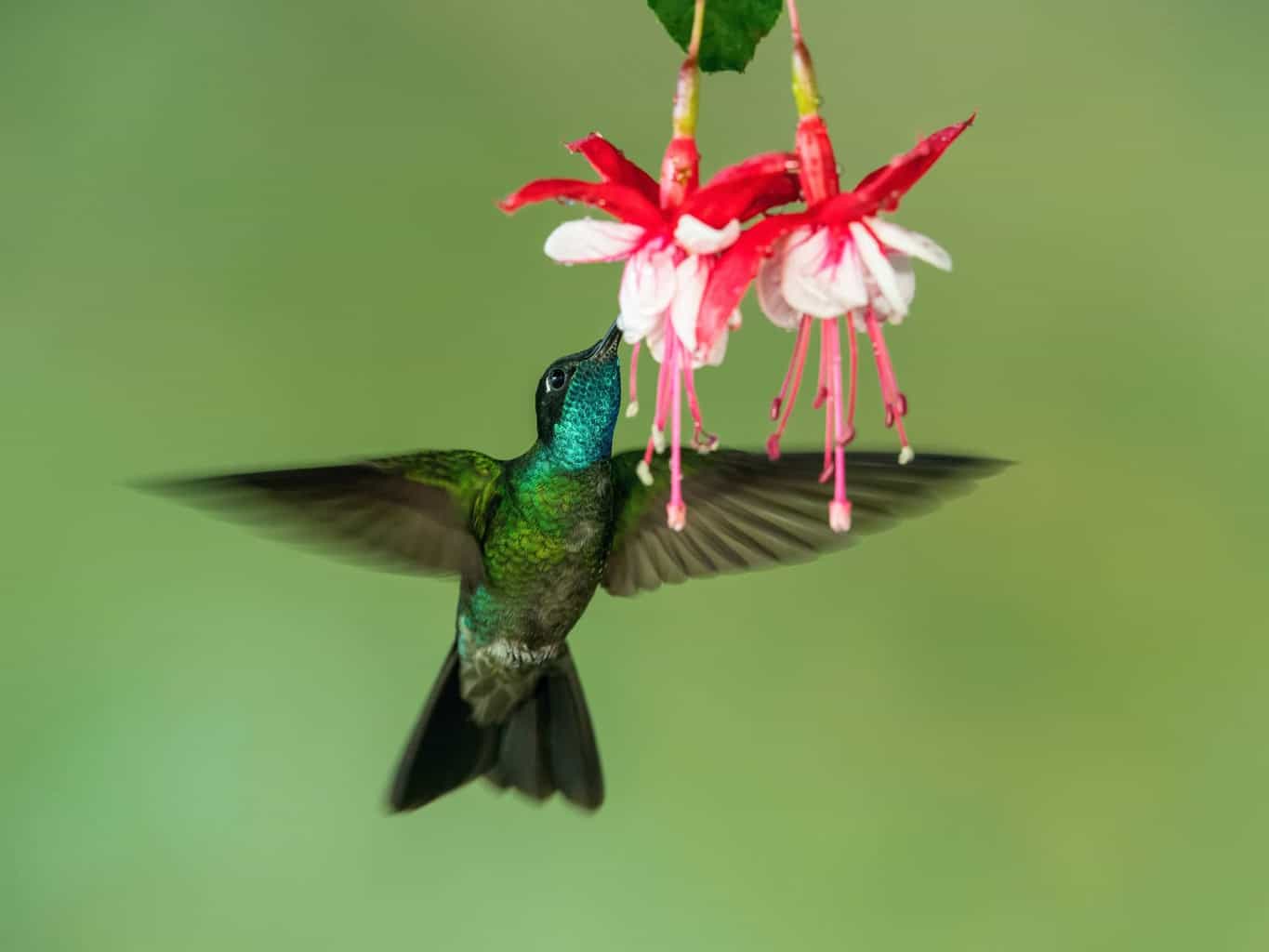
- Scientific name: Eugenes fulgens
- Length: 4.3 – 5.5 inches
- Weight: 0.21 – 0.35 ounce
- Wingspan: 7.1 inches
Males have a metallic green iridescent throat with a black chest. They have a purple head, and the back is dark green.
A female’s chest is a solid gray, and the back and crown are olive green. The tail feathers are pearl-gray-tipped and they have a pale belly.
These birds breed in the mountains from the southwestern United States to Honduras and Nicaragua. They live by the edges and clearings of montane oak forests.
The female makes a nest high in the trees, often overhanging streams. The nest is an open cup containing soft feathers, mosses, and small leaves.
Ruby-Throated Hummingbird
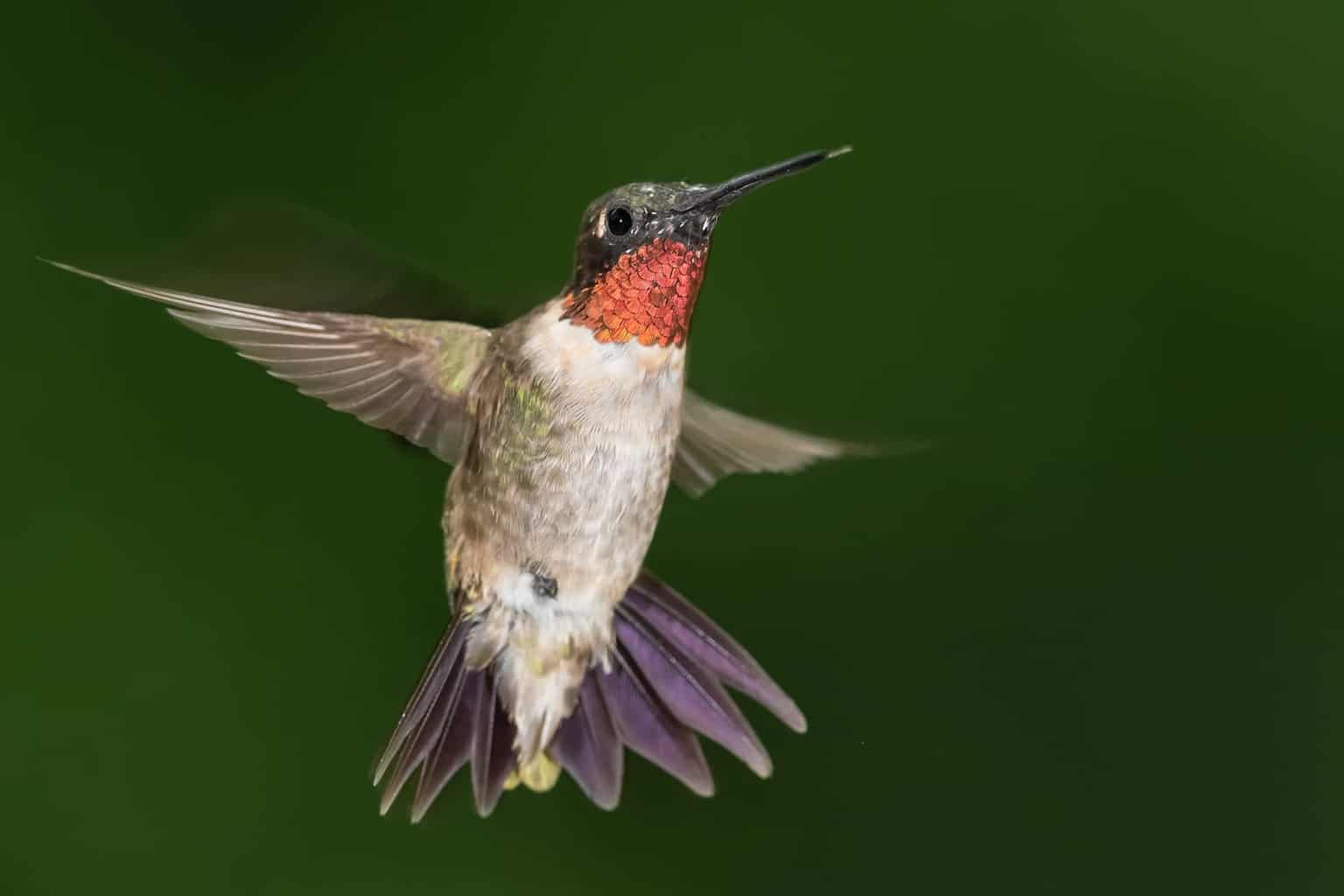
- Scientific name: Archilochus colubris
- Length: 2.8 – 3.5 inches
- Weight: 0.071 – 0.212 ounce
- Wingspan: 3.1 – 4.3 inches
Males have a ruby-red throat, a white collar, and an emerald green back with a black forked tail and violet sheen.
Females have a white throat, green back, and tail feathers banded white, black, and gray-green.
Ruby-throated hummingbirds are migratory and spend most of the winter in Florida, southern Mexico, and Central America.
These popular birds are pretty solitary, being less social than other birds, except during courtship (which lasts a few minutes).
Cinnamon Hummingbird
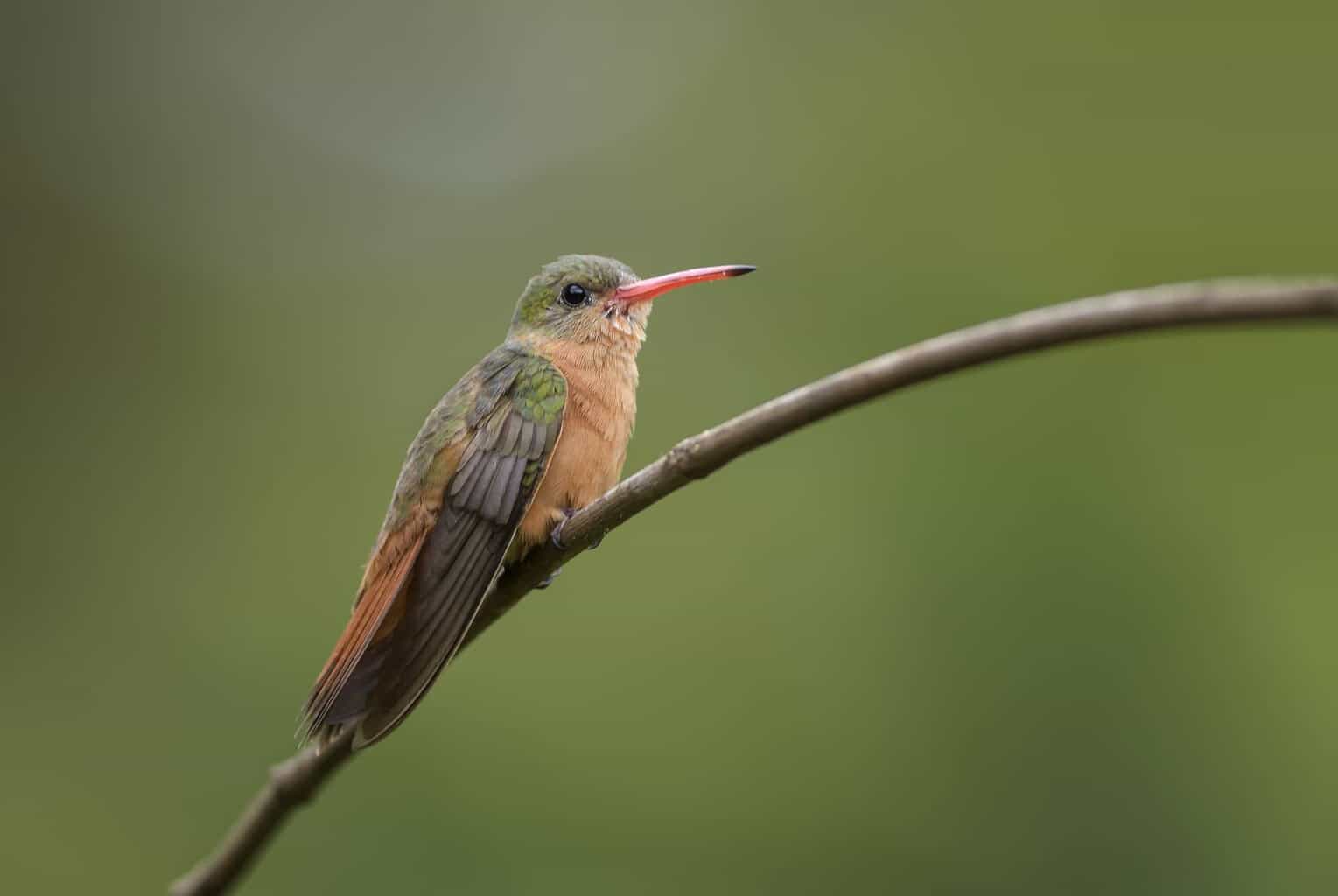
- Scientific name: Amazilia rutila
- Length: 3.9 inches
- Weight: 0.18 ounce
- Wingspan: 5.5 inches
The upperparts are metallic bronze-green, with the underparts being a cinnamon color, paler on the chin and upper throat.
The wings are dark, and the bill is red with a black tip.
Cinnamon hummingbirds are a part of the Trochilidae family and range from northwestern Mexico to Costa Rica.
Their preferred habitat is subtropical or tropical dry forests and heavily degraded former forests.
Berylline Hummingbird
- Scientific name: Saucerottia beryllina
- Length: 3.1 – 3.9 inches
- Weight: 0.14 – 0.17 ounce
- Wingspan: 5.75 inches
These Mexican hummingbirds have a bright green head with green feathers traveling down from their bill, past their green throat, to their rump, where the color shifts to a rusty gray down to the tail. They also have reddish wings.
The feathers of the slightly forked tail also have a glimmering purple shade that blends with the rufous color.
Berylline hummingbirds breed in forests and thickets ranging from western Mexico to central Honduras.
These hummingbirds are essentially non-migratory and tend to relocate later than other species.
Allen’s Hummingbird
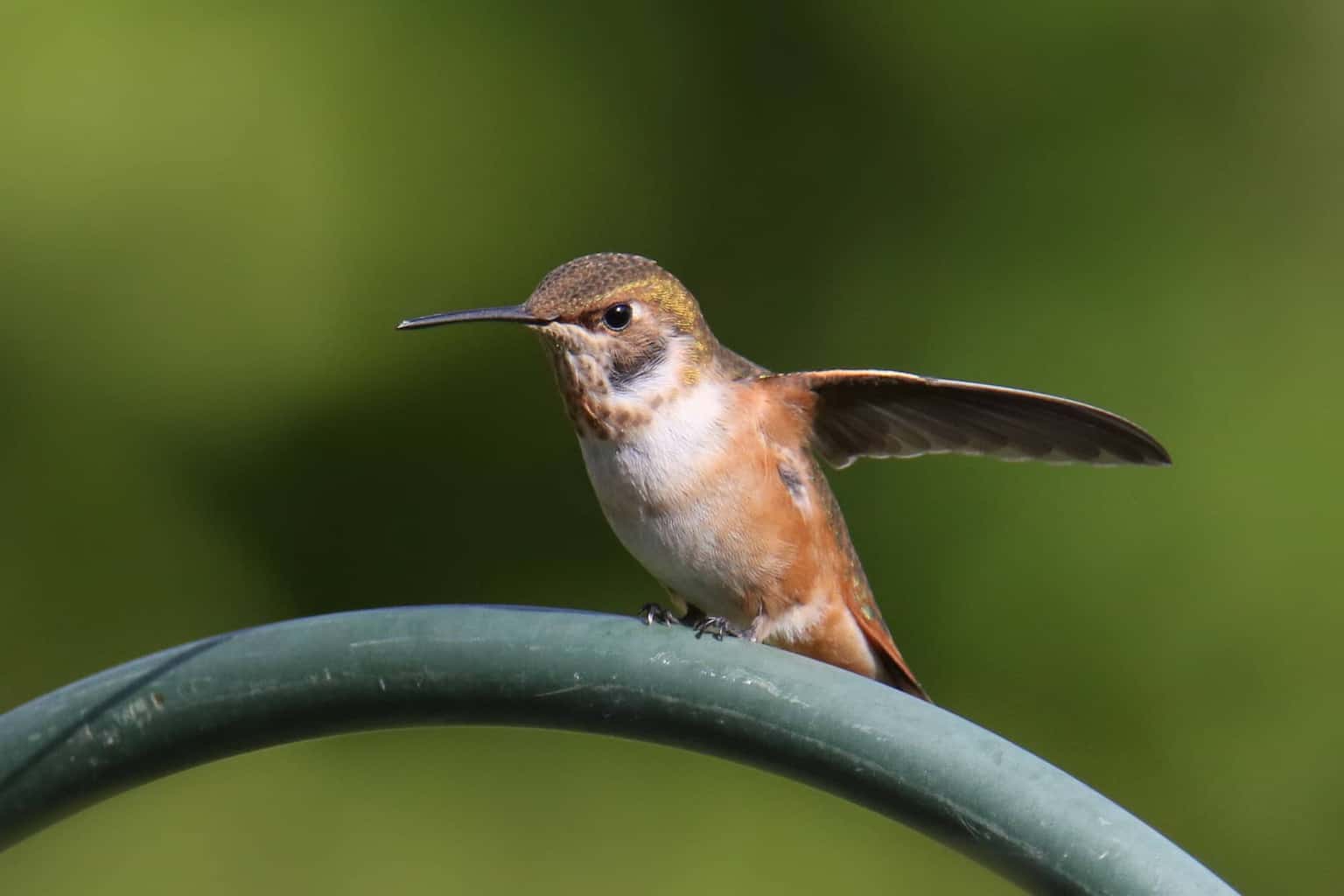
- Scientific name: Selasphorus sasin
- Length: 3.0 – 3.5 inches
- Weight: 0.1 ounce
- Wingspan: 4.3 inches
Males have iridescent reddish-orange throats. Their back is a bright green. Their rump is rufous, and their tail feathers are rufous with black tips.
Females have brownish-orange flanks and are similar in appearance but lack the glossy orange patch.
Allen’s hummingbirds live in the bushy woods, gardens, and coastal forest of California from Santa Barbara north to southern coastal Oregon. They have a limited breeding range.
They build their nests out of plant fiber and weed stems, coating the nest with lichens and spider webs to give it structure. The male performs acrobatics to woo the female. The eager hummingbird will fly up 100 feet in the air to dive toward the female and impress her with his stopping power and agility in an elaborate breeding display.
Plain-Capped Starthroats
- Scientific name: Heliomaster constantii
- Length: 4.33 – 4.72 inches
- Weight: 0.24 – 0.28 ounce
- Wingspan: 7 inches
Both genders have a dark, metallic bronze upper plumage with a white patch on the back and rump. The plumage beneath is grayish white. In addition, both have a dark stripe with a white line above and below the eye.
Males have a metallic violet-red throat patch. The plumage of a female is a bit less colorful and lacks the throat patch.
Plain-capped Starthroats breed in different habitats from western Mexico (the Sierra Madre Occidental) to southern Costa Rica.
In the United States, people can spot the bird in the Chiricahua and Huachuca Mountains during hummingbird season between mid-June and mid-September.
Conclusion
All of these hummingbird types are pretty similar in size. However, their weight and wingspans vary, and the habitats they prefer to rest in also depend on the species.
Males primarily appear to be shinier and brighter than females. Across all the species, you can view a vast spectrum of colors with these charming tiny fellows. For more information, check out this list of other birds in New Mexico.

